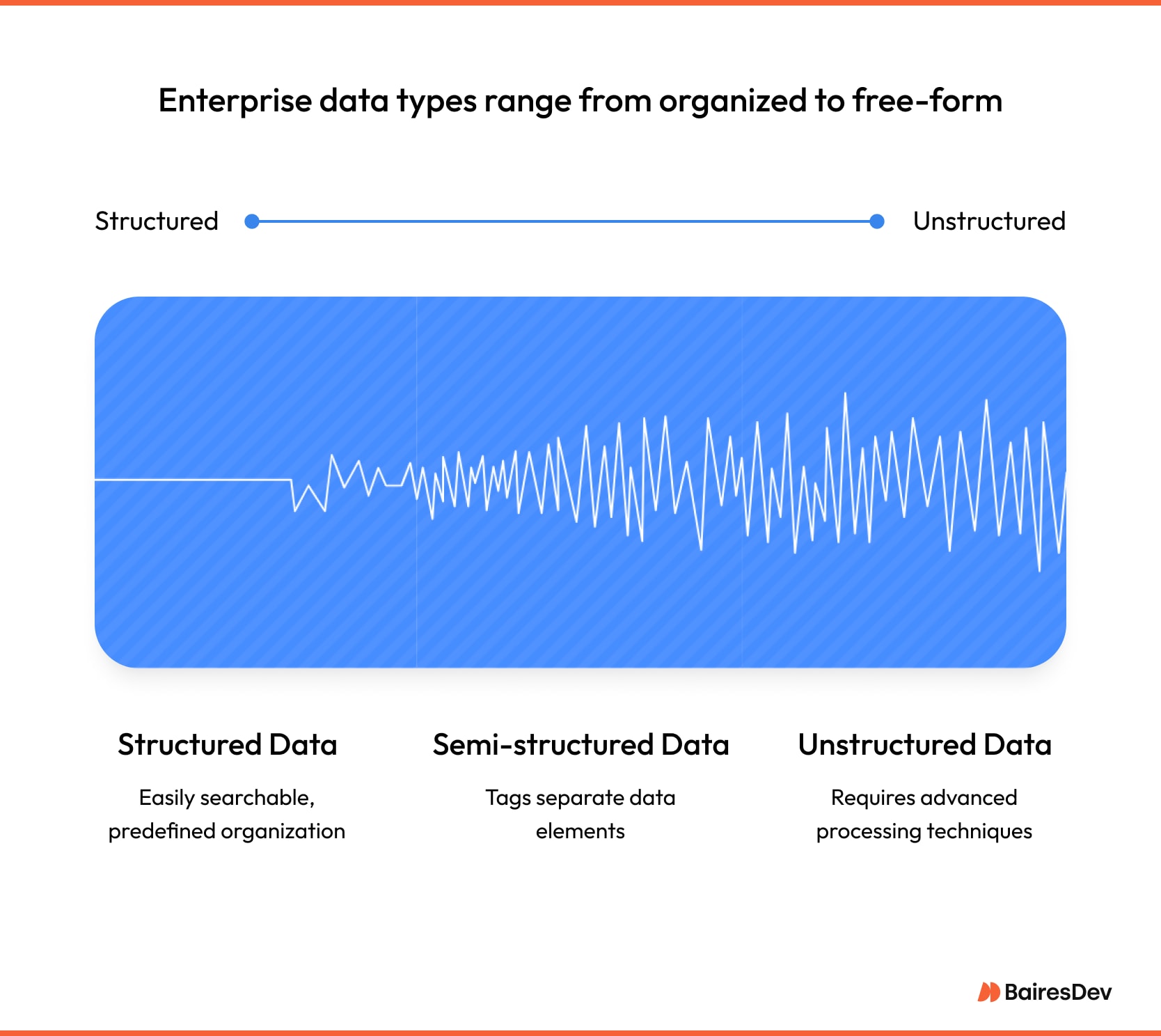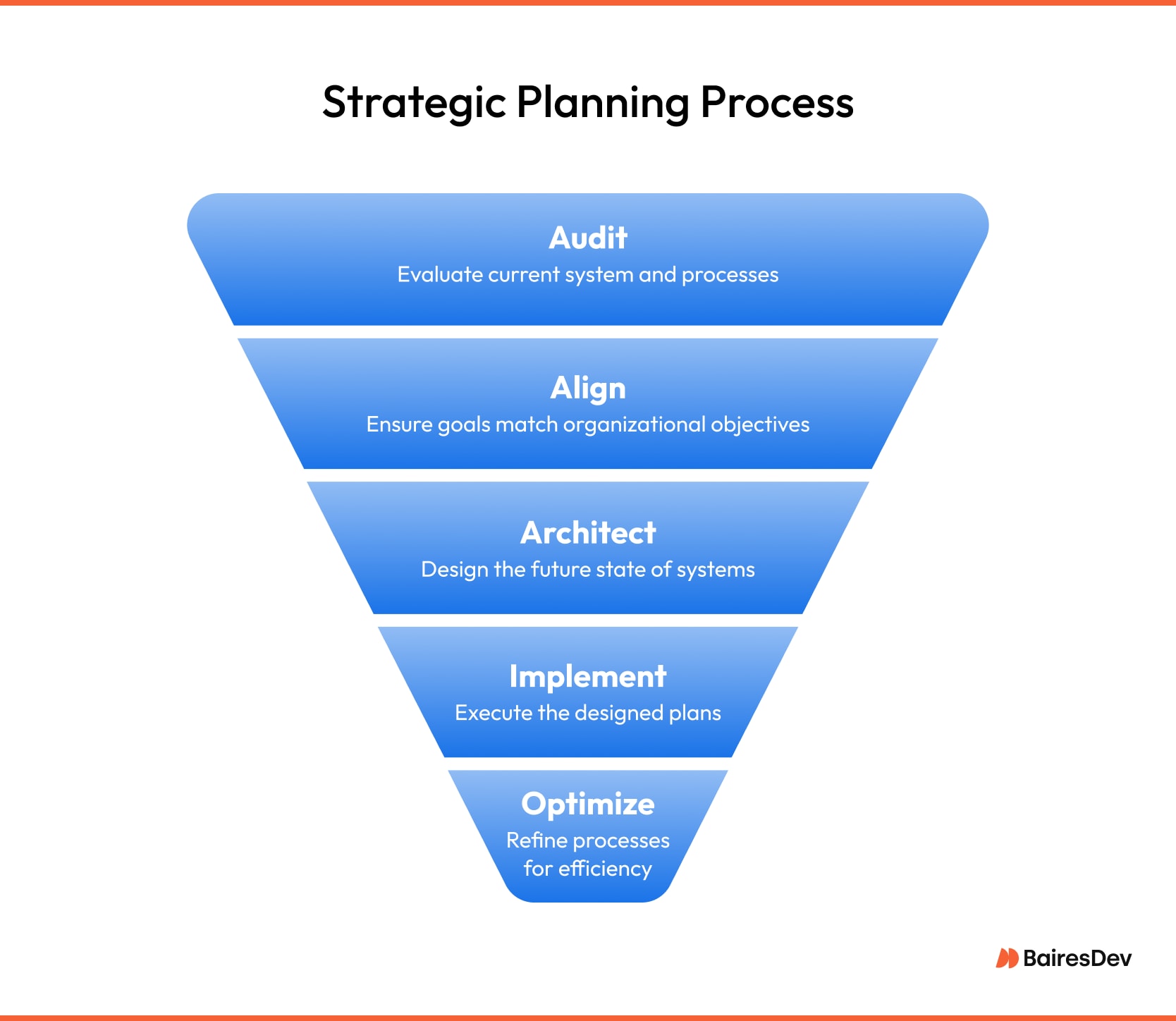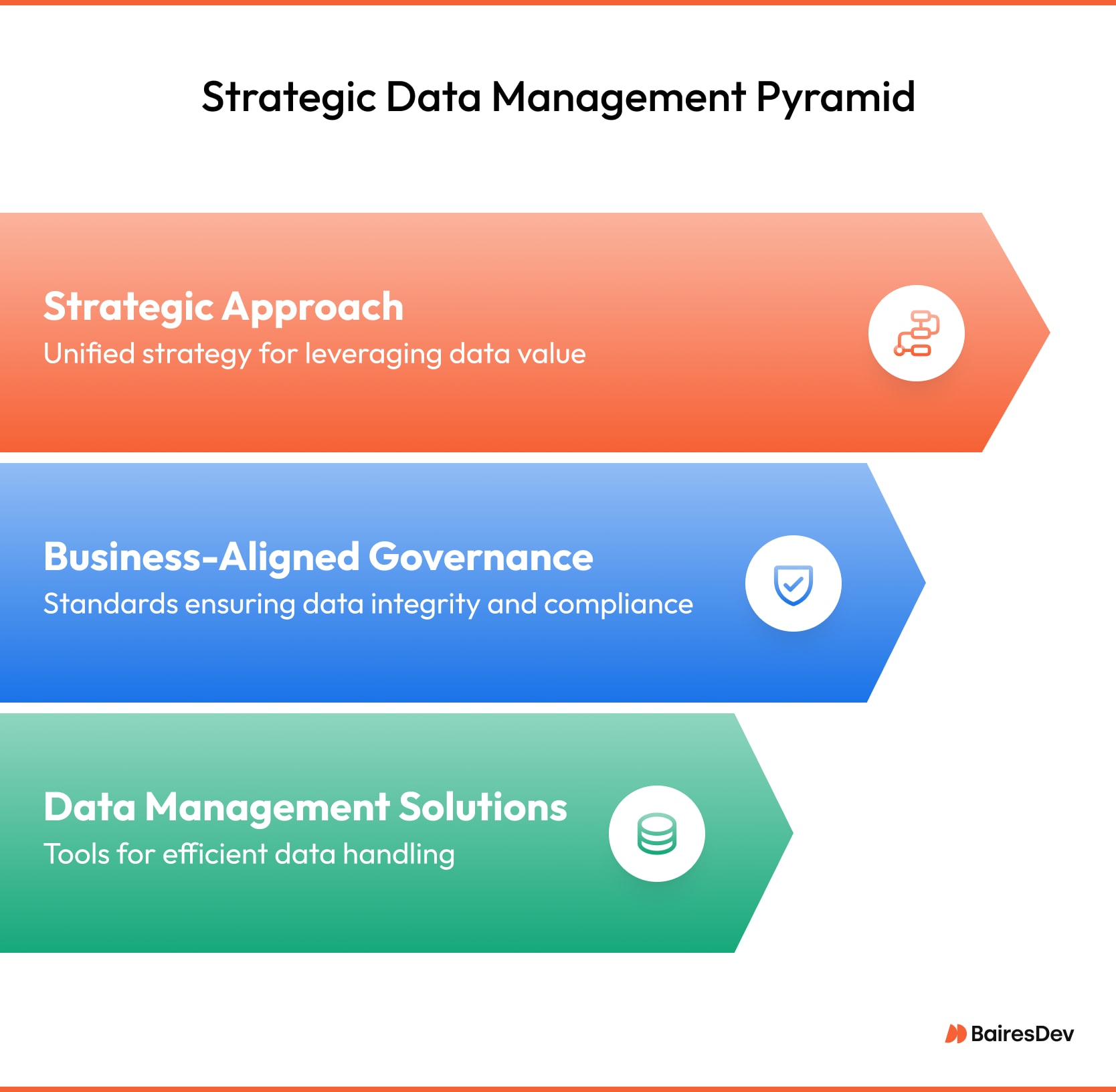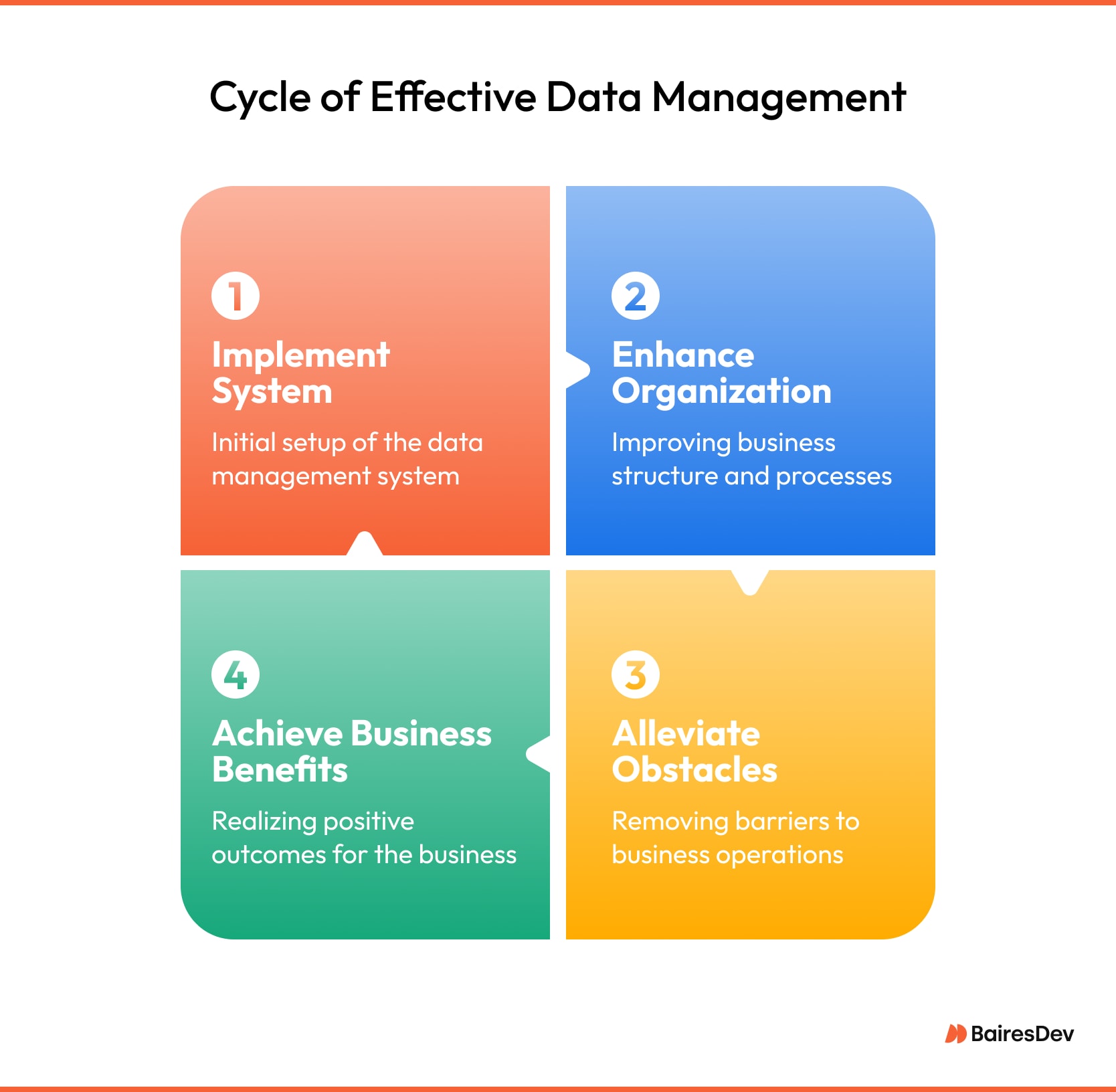Enterprise data volumes keep climbing, but most organizations still struggle to turn that data into faster decisions. Without a straightforward approach to managing information across platforms, most companies struggle to extract value.
Data silos, inconsistency, and poor governance can slow down decision-making and drive up costs. The growing data volume, the rise of generative AI, and tightening regulations are forcing a reevaluation of legacy practices and how to manage data.
At BairesDev, we can help you develop such solutions and provide a customized platform to unify your data in a single, central source.
Before exploring what that may mean for you, it’s helpful to step back and define the fundamentals.
What Is Data Management?
Data management refers to how your organization collects, stores, organizes, and governs data across its digital ecosystem. That includes everything from transaction logs and CRM data to third-party integrations and cloud services.
At its core, data management means that the right people have access to reliable data in the right format, without compromising on security or compliance.
While early solutions focused on relational databases, today’s landscape is far more complex.
Enterprises juggle structured, semi-structured, and unstructured data across on-prem, hybrid, and cloud environments. Modern architectures may include data warehouses, lakes, lakehouses, and more recently, data meshes or data fabrics.
These technologies aim to reduce friction between business units and IT by making data more discoverable and usable across the organization.
Types of Data Enterprises Manage

A typical enterprise environment includes a broad mix of:
Structured Data
This is the most familiar form of enterprise data: organized in rows and columns, typically housed in relational databases. It includes information from systems like ERP platforms, CRM tools, and financial applications, such as customer records, transaction histories, and inventory data.
Structured data is easy to query and integrates well into reporting tools and dashboards.
Unstructured Data
Unstructured data lacks a predefined schema and is harder to organize and analyze using traditional tools. It includes emails, videos, PDFs, chat transcripts, meeting recordings, and social media content.
Despite the complexity and the challenges it creates for the data management process, this data often holds valuable context and insight, especially for customer service, compliance, and sentiment analysis. Effective strategies must account for both storage and content discovery across formats.
Semi-Structured Data
Semi-structured data sits between structured and unstructured formats. It has organizational properties but doesn’t fit neatly into a relational database. Common examples include application logs, IoT sensor outputs, and API responses—often formatted in JSON, XML, or YAML.
This data is critical for operational monitoring, system diagnostics, and real-time analytics, but requires flexible processing pipelines and metadata tagging to be usable at scale.
The challenge is variety, velocity, and veracity. Your data governance strategies must account for how these types interact.
Why Data Management Systems Matter to the Business
Effective usage of a data management system is a business enabler. If done well, it supports your organization and removes frictions across the business.
Faster, More Confident Decisions
Clean, accessible data improves forecasting. Leaders can make decisions based on consistent views of customer behavior or product performance.
Operational Efficiency
Integrated systems reduce duplication and delays. Whether it’s finance closing the books faster or marketing building more accurate segments, good data shortens cycles.
Compliance and Risk Mitigation
A good data management solution prevents your data from falling through the cracks and into the wrong hands while also leveraging the benefits of the latest security technologies to safeguard the information you have.
Data Security at Scale
Centralized policies and monitoring reduce the risk of data breaches. Data governance tools also support role-based access and auditing.
Cost Reduction
By consolidating storage and minimizing the movement of low-value data, companies can save on infrastructure costs. Automated workflows also reduce reliance on manual data processing.
Rethinking Data Management Strategy
You should think of your data management strategy as “a long-term future state document that demonstrates the intention of a company to manage and use data by its business strategy.”

Before committing to a particular data management solution or developing your own with the help of a custom software development company, you need to have a clear understanding of where you want to go with it.
You should consider the following:
• Understand your key business objectives and check what data you’re collecting (and which one you can collect) towards those goals.
• Based on your goals, define who’ll get access to each data set, detailing why any given individual or area should have the authorization to access that information.
• Define strategies for protection, storage, and usage of the data, applying specific policies to each data subset.
• Establish different levels within the strategy to ensure that your data management is flexible enough to address different goals.

Data Storage Importance
If your teams are still spending more time moving data than using it, your storage approach might be part of the problem.
Today’s enterprise environments rarely rely on a single storage model. Most use a mix of centralized systems for consistency and distributed platforms for flexibility.
What matters is how well those systems support actual business needs: reliable access, security, scale, and clear ownership.
Storage decisions should support the way teams function —not create delays, manual workarounds, or uncertainty about data quality. When storage becomes a barrier to using data confidently and efficiently, it’s a sign that the underlying strategy needs to be revisited.
Data Storage Solutions
Traditional data storage solutions include data warehouses, which store structured data in a centralized repository. Data warehouses are ideal for handling large volumes of structured data.
Data lakes, in contrast, store raw, unstructured data in a more flexible environment. This approach allows organizations to store vast amounts of diverse data types without the need for immediate structuring, making it easier to perform advanced analytics and machine learning.
Other modern data management practices also include scalable cloud-based storage solutions, such as object storage and cloud-based data warehouses.
Additionally, emerging technologies such as data fabrics and data meshes enable more efficient management and access to data across multiple sources and locations, thereby breaking down data silos and enhancing data integration.
Best Practices to Maintain Momentum

No data platform can function effectively without a clear strategy in place. These practices help teams stay focused, avoid duplication, and respond to change. After developing the strategy with the steps mentioned above, consider the following best practices.
Have a data management team available at all times
Given the complexity of data management-related tasks, you need to have a dedicated team of data management professionals to handle them correctly. Having the right professionals can help you develop and adjust your approach.
Naturally, you can always trust an outsourced development team or augment your staff with data engineers if you don’t have someone in-house.
Focus on data privacy
Compliance with new data protection legislation is a must for anyone involved in data management.
This means implementing the proper measures to protect and store your data, while also allowing for data auditing that demonstrates your compliance.
Periodically update your approach
There isn’t a data management strategy that’s set in stone, simply because data management is a dynamic field that’s constantly evolving.
Because security systems and regulations are constantly evolving, you must maintain a vigilant eye on your processes to introduce relevant modifications that keep your system robust in the face of cyberattacks.
Assess your data management performance
All business strategies require measurement and assessment of their performance. Data management components support performance assessment by improving capabilities through evolving technologies like hybrid cloud and artificial intelligence.
Define metrics that will help you understand how your data management efforts are paying off and that let you dive into your system’s performance.
If something is failing, it may be time to consider changing providers or developing a custom data management solution.
Common Enterprise Data Management Challenges
Even mature organisations hit roadblocks:
- Data silos: Teams maintain separate systems with overlapping or conflicting information.
- Poor data quality: Inaccurate or inconsistent data undermines trust in analytics.
- Legacy tech: Older systems may lack API support or create extract/load bottlenecks.
- Under-resourced data teams: Many enterprise teams are understaffed, especially for governance roles.
Overcoming these requires more than tools. It takes executive alignment, cultural change, and sustained investment.
Getting Started
Start with the data you already have and the friction in your current workflows. Then build around those needs.
If you’re evaluating or rethinking your enterprise data strategy, the first step is to understand your data landscape and business priorities.
At BairesDev, we work with enterprise clients to identify gaps and align their architecture with business goals.
Our teams bring experience across industries, regulatory environments, and data platforms—from modernising legacy systems to building cloud-native analytics stacks.
If you’re ready to cut through the noise and improve how your business uses data, BairesDev’s nearshore data management experts can help you rethink and rebuild. Request a data strategy alignment session with our enterprise architects.
FAQ
How do I know if my current data strategy is holding us back?
You’ll see signs in slow decision cycles, inconsistent reports, or frequent workarounds by your teams. If different departments can’t agree on metrics, if IT is constantly reconciling data manually, or if compliance reviews are painful, your data strategy likely needs a reset.
What’s the ROI of investing in better data governance?
The most significant returns come from faster, more reliable decisions and reduced risk exposure. It also lowers infrastructure costs by eliminating duplicate storage and shadow systems.
How fast can a nearshore partner help us operationalize our data?
Assuming you have access to your systems and a clear objective, a nearshore team can start delivering value in weeks. Typical early wins include data pipeline clean-up, dashboard consolidation, or automating reporting. The key is to start with a well-defined use case, then scale from there.
When should we build vs. buy a data management platform?
Buy when your needs are standard—like integrating common data sources, complying with typical regulations, or supporting known analytics tools. Build when your workflows are unique, your scale is high, or you need deep control over security, orchestration, or customization.
Which data management tools are essential for building an effective data management strategy across on-prem and multi-cloud workloads?
Prioritize three classes: a centralized metadata catalog for lineage and discovery, an orchestration layer (e.g., Airflow or Prefect) to govern pipelines end-to-end, and a policy-driven security platform that enforces least-privilege access. Together they give leaders confidence that data is visible, trustworthy, and auditable at scale.
Where do data preparation and data discovery fit into the analytics pipeline, and how do they accelerate data scientists’ productivity?
Data preparation cleanses and standardizes raw inputs; data discovery surfaces what already exists and highlights relationships. Together they cut the time data scientists spend hunting and wrangling data—often 60-70 % of a project—so they can prototype models faster and iterate with stakeholders in real time.
Why is proper data management the first line of defense for sensitive data subject to GDPR, CCPA, or HIPAA?
Proper data management embeds classification, masking, and retention controls at ingestion rather than bolting them on later. That eliminates shadow copies, simplifies compliance reviews, and cuts breach-response time from weeks to hours.






